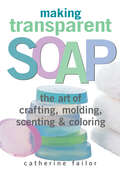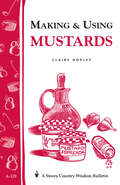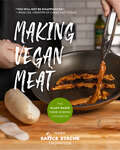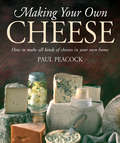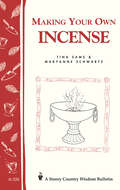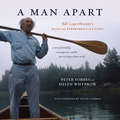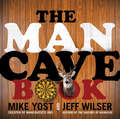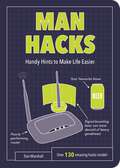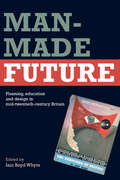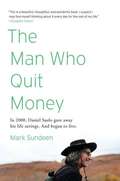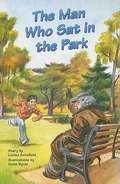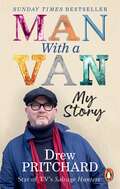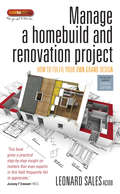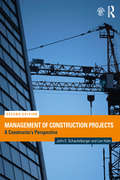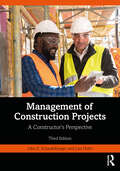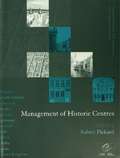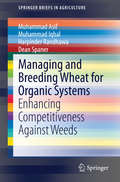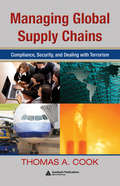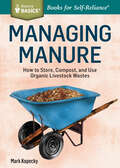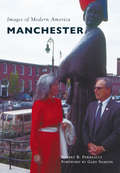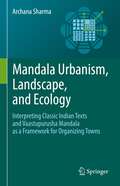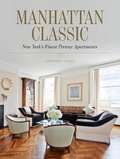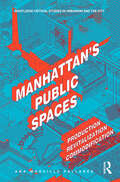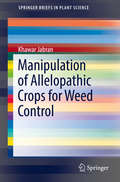- Table View
- List View
Making Transparent Soap: The Art Of Crafting, Molding, Scenting & Coloring
by Catherine FailorWith basic ingredients and standard kitchen tools you can craft your own transparent soaps that are milder, richer, and creamier than any commercial product. Eschewing complex methods and expensive equipment, Catherine Failor uses a simple, dependable process that makes beautiful transparent soaps every time. Failor’s easy-to-follow photographic instructions are accompanied by proven recipes and plenty of suggestions for colorful and sweet-smelling variations. You’ll soon be creating your own signature soap blends that deliver refreshing scents and are gentle enough for even the most sensitive skin.
Making & Using Mustards: Storey's Country Wisdom Bulletin A-129
by Claire HopleySince 1973, Storey's Country Wisdom Bulletins have offered practical, hands-on instructions designed to help readers master dozens of country living skills quickly and easily. There are now more than 170 titles in this series, and their remarkable popularity reflects the common desire of country and city dwellers alike to cultivate personal independence in everyday life.
Making Vegan Meat: The Plant-Based Food Science Cookbook
by Mark "Sauce ThompsonThe Vegan Cookbook That Is Rooted in Food Science"Mark is an absolute wizard―he can turn the most unexpected ingredients into vegan meat! You will not be disappointed."―Rose Lee, Cheap Lazy Vegan#1 Bestseller in Raw Cooking, Vegan Cooking, and Vegetarian DietsA one-of-a-kind vegan cookbook for those looking to make juicy burgers, sizzling BBQ ribs, Seitan Bacon, and fried chicken, all through the power of fruits and vegetables.For all food lovers and enthusiasts out there. Making Vegan Meat is a staple cookbook for kitchens where home cooks, professional chefs, foodies, vegans, vegetarians, and the vegan-curious can find super vegan meat recipes. Foodie, food scientist, and YouTuber Mark “Sauce Stache” Thompson shows you a multitude of filling vegan dishes to deeply satisfy your tastebuds.Make nutritious and creative recipes in this vegan cookbook. Step out of your comfort zone and have fun with healthier, delicious, plant based protein. From mouth-watering BBQ ribs made from mushrooms to crispy bacon from a daikon radish, you will have your dinner guests exclaiming, “Wait! That’s a vegetable?”Read Making Vegan Meat and:Learn to experiment in the kitchen with unexpected ingredients and create your own plant-based vegan meat recipesGain insight into how to produce different flavors, textures, and aromasDiscover exciting ways to use a variety of fruits and vegetables, like mushrooms!If you enjoyed plant-based cookbooks like The Complete Plant-Based Cookbook, Vegan for Everybody, or The Vegan Meat Cookbook, then you’ll love Making Vegan Meat.
Making Your Own Cheese: How to Make All Kinds of Cheeses in Your Own Home
by Paul PeacockNot everyone can keep a cow, but everyone can make cheese. This book shows you the very basic equipment needed to make your own cheese: the ingredients, including different milks, herbs and flavours; how to make a simple cheese; and how to produce some of the worlds speciality cheeses such as Roquefort, Brie and Edam. You will find recipes for making many cheeses at home. Whether you are making a cheese cake, a ricotta-based pudding or a stonking salty blue, this book is a cheese lover s guide to making their own favourite food and there are some recipes for the biscuits to go with it, too.
Making Your Own Incense: Storey Country Wisdom Bulletin A-226 (Storey Country Wisdom Bulletin Ser.)
by Tina Sams Maryanne SchwartzSince 1973, Storey's Country Wisdom Bulletins have offered practical, hands-on instructions designed to help readers master dozens of country living skills quickly and easily. <P><P>There are now more than 170 titles in this series, and their remarkable popularity reflects the common desire of country and city dwellers alike to cultivate personal independence in everyday life.
A Man Apart
by Helen Whybrow Peter ForbesA story of friendship, encouragement, and the quest to design a better world A Man Apart is the story--part family memoir and part biography--of Peter Forbes and Helen Whybrow's longtime friendship with Bill Coperthwaite (A Handmade Life), whose unusual life and fierce ideals helped them examine and understand their own. Coperthwaite inspired many by living close to nature and in opposition to contemporary society, and was often compared to Henry David Thoreau. Much like Helen and Scott Nearing, who were his friends and mentors, Coperthwaite led a 55-year-long "experiment in living" on a remote stretch of Maine coast. There he created a homestead of wooden, multistoried yurts, a form of architecture for which he was known around the world. Coperthwaite also embodied a philosophy that he called "democratic living," which was about empowering all people to have agency over their lives in order to create a better community. The central question of Coperthwaite's life was, "How can I live according to what I believe?" In this intimate and honest account--framed by Coperthwaite's sudden death and brought alive through the month-long adventure of building with him what would turn out to be his last yurt--Forbes and Whybrow explore the timeless lessons of Coperthwaite's experiment in intentional living and self-reliance. They also reveal an important story about the power and complexities of mentorship: the opening of one's life to someone else to learn together, and carrying on in that person's physical absence. While mourning Coperthwaite's death and coming to understand the real meaning of his life and how it endures through their own, Forbes and Whybrow craft a story that reveals why it's important to seek direct experience, to be drawn to beauty and simplicity, to create rather than critique, and to encourage others.
The Man Cave Book
by Michael H. Yost Jeff WilserWhat separates the men from the boys? The Man Cave. Boyhood Fort Man Cave Who's allowed Not girls-they have cooties Not women-they have authority Primary materials used in construction Wood, stuff your mom doesn't want Particleboard, stuff your wife doesn't want Key activities inside Goofing around, avoiding responsibility Goofing around, avoiding responsibility Peak periods of use After school, weekends After work, weekends Slumber parties with buddies? Yes No Food and beverages consumed Soda and unhealthy snacks Beer and unhealthy snacks Spend the night inside? Not as a habit, but it's been known to happen Not as a habit, but it's been known to happen Money spent on space As little as possible As much as possible Is this a phase you will outgrow? Yes No The Man Cave Book is a tribute to great and glorious man spaces and the craftsmen behind them. Complete with instructions and insights into creating your own unique refuge and shrine to beer, sports, and everything else that's right with the world, this is an essential manual for any man cave enthusiast.
Man Hacks: Handy Hints to Make Life Easier (Life Hacks Ser.)
by Dan MarshallMAN HACKS is the ultimate guide to making essential guy stuff easier. This fully illustrated manual covers everything from culinary cheats, DIY secrets and tidying-up shortcuts to style tips and party tricks – everything you need to keep your man credentials fully in check.
Man-Made Future: Planning, Education and Design in Mid-20th Century Britain
by Iain Boyd WhyteThis anthology of essays by a group of distinguished scholars investigates post-1945 city planning in Britain; not from a technical viewpoint, but as a polemical, visual and educational phenomenon, shifting the focus of scholarly interest towards the often-neglected emotional and aesthetic aspects of post-war planning. Each essay is grounded in original archival research and sheds new light on this critical era in the development of modern town planning. This collection is a valuable resource for architectural, social and urban historians, as well as students and researchers offering new insights into the development of the mid-twentieth century city.
The Man Who Quit Money
by Mark SundeenA Walden for the 21st century, the true story of a man who has radically reinvented "the good life" In 2000, Daniel Suelo left his life savings; all thirty dollars of it; in a phone booth. He has been living without money; and with a newfound sense of freedom and security; ever since. The Man Who Quit Money is an account of how one man learned to live, sanely and happily, without earning, receiving, or spending a single cent. Suelo doesn't pay taxes, or accept food stamps or welfare. He lives in caves in the Utah canyonlands, forages wild foods and gourmet discards. He no longer even carries an I. D. Yet he manages to amply fulfill not only the basic human needs-for shelter, food, and warmth-but, to an enviable degree, the universal desires for companionship, purpose, and spiritual engagement. In retracing the surprising path and guiding philosophy that led Suelo into this way of life, Sundeen raises provocative and riveting questions about our relationships with money and the decisions we all make, by default or by design; about how we live and how we might live better.
The Man Who Sat in the Park (Rigby PM Plus Non Fiction Ruby (Levels 27-28), Fountas & Pinnell Select Collections Grade 3 Level Q)
by Louise Schofield Suzie ByrneBradley becomes friendly with Stan, an old homeless man in the park. Bradley volunteers to help at the men’s shelter and finds out more about his new friend. Stan makes Bradley a paper boat to sail in the park pond. One day, Stan doesn’t show up in the park and Bradley discovers he has been taken to hospital. When Stan dies, Bradley’s parents give him a model boat to remind him of his friend.
Man with a Van: My Story
by Drew PritchardSunday Times bestseller'When I see something old, that I think is beautiful, special, valuable, it's not about the money. It's about being in another time and place.'Star of TV's Salvage Hunters, Drew Pritchard will go to the greatest lengths for the best deals. He discovered the casts Lord Elgin made of his infamous marbles in a school garage, and broke the bank to buy the tool box Malcolm Campbell used when he set the water speed record in 1934. He made a million. Lost it. And made it again.The face of the compulsively fascinating business of finding and restoring lost treasures, visionary Drew takes us up and down the country, into garages, factories, schools and pubs, digging out incredible items from that 'other time and place'. Then by lovingly restoring them, he brings our history back to life.A flat cap among silver spoons and old school ties, our favourite no-bullshit expert may be a one-off, but his story makes us all dream of that obscure piece of antiquity gathering dust in the garden shed...
Manage A Home Build And Renovation Project 4th Edition: How To Fulfil Your Own Grand Design
by Leonard SalesUndertaking a building or renovation project can be a bit daunting. But with the help of this book you will be in control at all times, confident in your decision making, and sure of getting the job done on time and to a high standard. It includes proven and simple-to-use management techniques that would suit projects ranging from one thousand to one million pounds.Contents: Introduction; About the author; 1. Getting started; 2. Know your requirements; 3. Contacting contractors; 4. Establishing credibility; 5. Obtaining and agreeing quotes; 6. Starting the work; 7. Financial arrangements; 8. Operation and maintenance manuals; 9. Good working relations; 10. Record-keeping; 11. Professional and site teams; Index
Manage A Home Build And Renovation Project 4th Edition: How to fulfil your own grand design
by Leonard SalesUndertaking a building or renovation project can be a bit daunting. But with the help of this book you will be in control at all times, confident in your decision making, and sure of getting the job done on time and to a high standard. It includes proven and simple-to-use management techniques that would suit projects ranging from one thousand to one million pounds.Contents: Introduction; About the author; 1. Getting started; 2. Know your requirements; 3. Contacting contractors; 4. Establishing credibility; 5. Obtaining and agreeing quotes; 6. Starting the work; 7. Financial arrangements; 8. Operation and maintenance manuals; 9. Good working relations; 10. Record-keeping; 11. Professional and site teams; Index
Management of Construction Projects: A Constructor's Perspective
by John E. Schaufelberger Len HolmUnlike the majority of construction project management textbooks out there, Management of Construction Projects takes a distinctive approach by setting itself in the context of a single and real-world construction project throughout and also by looking at construction project management from the constructor’s perspective. This project-based learning approach emphasizes the skills, knowledge, and techniques students require to become successful project managers. This second edition uses a brand new, larger, and more challenging case study to take students through key stages of the process, including: contracts and subcontracting; estimating, scheduling, and planning; supply chain and materials management; cost control, quality, and safety; project leadership and ethics; and claims, disputes, and project close-outs. Also new to this edition is coverage of emergent industry trends such as LEAN, LEED, and BIM. The book contains essential features such as review questions, exercises, and chapter summaries, while example plans, schedules, contracts, and other documents are stored on a companion website. Written in straightforward language from a constructor’s perspective, this textbook gives a realistic overview and review of the roles of project managers and everything they need to know in order to see a successful project through from start to finish.
Management of Construction Projects: A Constructor's Perspective
by John Schaufelberger Len HolmUnique among construction project management textbooks, Management of Construction Projects, third edition, takes the constructor’s perspective, carefully analyzing a complex, real-world construction case study from multiple angles to demonstrate the skills, knowledge, and techniques students require to become successful project managers. Popular as an undergraduate text and as a contractor resource, the book identifies key stages of the project-management process, such as delivery methods and contracts; estimating, planning, and scheduling; preconstruction services; subcontracting and material management; documentation, communications, and payment; controls, quality, and safety; leadership and ethics; and claims, disputes, and close-out.This third edition includes a novel case study, a new chapter on preconstruction services, updated contract forms and figures, and additional student exercises, and integrates use of project management technology. Topics include building information models, sustainable construction, environmental compliance, lean construction, and off-site construction. Boxed examples, or short case studies, have been included with each chapter. These examples correspond directly to the chapters in which they are included and give the reader an applied approach to learning the concepts presented.While primarily focused on the management of commercial projects, the principles and techniques in Management of Construction Projects also apply to residential, industrial, and heavy construction. Written in straightforward language from a constructor’s perspective, this textbook prepares upcoming construction project managers with everything they need to see a successful project through from start to finish.
Management of Historic Centres (Conservation Of The European Built Heritage Ser.)
by Robert PickardThis book examines key themes for the management of historic urban centres within a representative sample of centres in different European countries. The twelve historic centres that have been chosen are spread throughout Europe. They are diverse in character and the range includes small towns, cities and urban centres within cities. Some have been designated by UNESCO as World Heritage Sites or Cities, whilst others have recognition, or have been proposed as European Cities of Culture. The centres have all faced different problems and a variety of approaches have been utilised which are also examined. For each of the historic centres in the book the authors broadly cover a number of common themes: the policy and planning framework; management and regeneration action; environmental management; tourism and heritage management; and sustainability.
Managing and Breeding Wheat for Organic Systems
by Muhammad Asif Muhammad Iqbal Harpinder Randhawa Dean SpanerGenetically uniform cultivars in many self-pollinated cereal crops dominate commercial production in high-input environments especially due to their high grain yields and wide geographical adaptation. These cultivars generally perform well under favorable and high-input farming systems but their optimal performance cannot be achieved on marginal/organic lands or without the use of external chemical inputs (fertilizers, herbicides and pesticides). Cereal breeding programs aim at evaluating candidate lines/cultivars for agronomic, disease and quality traits in a weed free environment that makes it impossible to identify traits conferring competitive ability against weeds. Moreover, quantification of competitive ability is a complex phenomenon which is affected by range of growth traits. Above (e. g. light) and below (e. g. water and nutrients) ground resources also influence competitiveness to a greater extent. Competitiveness is quantitatively inherited trait which is heavily influenced by many factors including genotype, management, environment and their interaction. Sound plant breeding techniques and good experimental designs are prerequisites for maximizing genetic gains to breed cultivars for organically managed lands. The brief is focused on breeding wheat for enhanced competitive ability along with other agronomic, genetic and molecular studies that have been undertaken to improve weed suppression, disease resistance and quality in organically managed lands. The examples from other cereals have also been highlighted to compare wheat with other cereal crops.
Managing Global Supply Chains: Compliance, Security, and Dealing with Terrorism
by Thomas A. CookSeptember 11, 2001 had a profound impact upon individuals, institutions, and governments, but also upon the world of global trade. Years later, the reverberations of this deliberate and focused act of terrorism are manifest in much more stringent logistics, documentary requirements, and regulations. A single source on compliance and security, writt
Managing Manure: How to Store, Compost, and Use Organic Livestock Wastes. A Storey BASICS®Title (Storey Basics)
by Mark KopeckyAnyone who raises livestock or keeps horses must deal with manure. This Storey BASICS® guide shows you how to make this process manageable, useful, and even profitable. Organic dairy farmer and soil scientist Mark Kopecky explains the fundamentals of storing, composting, and spreading manure; the nutritional content of manure from various animals; and how to handle, transport, and market manure for additional income. You’ll soon discover that your farm’s waste may be its biggest asset.
Manchester: Vivre La Difference (Images of Modern America)
by Gary Samson Robert B. PerreaultKnown as New Hampshire�s �Queen City,� Manchester could be called �Change City.� Throughout its history, it has reinvented itself many times. From a Native American fishing and gathering place called Amoskeag to a Yankee colonial town known as Derryfield, it became a multiethnic industrial center, the �Manchester of America,� home of the world-famous Amoskeag Manufacturing Company (1831�1936). When Amoskeag Manufacturing closed during the Depression, �the city that would not die� was reborn through more diversified industries that carried it through the post�World War II era. Several decades of urban renewal saw the demolition of many older buildings and entire neighborhoods. Lamenting the loss of Boston & Maine Railroad�s Union Station and St. Mary�s Bank�s marble building, Manchester residents drew inspiration from the US bicentennial in 1976 to create a renaissance of interest in history and architecture, which brought about the adaptation to modern use of several remaining older structures. Yet more major losses came in 1978 and 1989 with the destruction of the State Theatre and Manchester�s beloved Notre Dame Bridge.
Mandala Urbanism, Landscape, and Ecology: Interpreting classic Indian texts and Vaastupurusha mandala as a framework for organizing towns
by Archana SharmaClassic Indian texts and Vaastupurusha Mandala are not often discussed in the western discourse on urbanism, even while much of these predate the commonly taught European writings. This book sheds light on some of those forgotten concepts, thus making the lesser discussed classic Indian town organization ideas accessible to architecture, landscape, and urban planning students worldwide. The resonance of these concepts in present times are reviewed through case studies of select Hindu temple towns in India. Furthermore, the author underscores the formal abstraction of the classic Indian Mandala and transplants the discourse from sociology to socio-ecologically adept trans-disciplinary design thinking. The creative interpretations offer a premise to start revising classic models for current practice to influence the urbanism and ecology of a place in accordance with the changing climate.
Manhattan Classic
by Geoffrey LynchThe Dakota. The Apthorp. The San Remo. The names of these legendary New York apartment buildings evoke images of marble-lined lobbies, uniformed doormen, and sunlit penthouses with sweeping Central Park views. Built from the 1880s through 1930s, classic prewar apartments were designed to lure townhouse dwellers reluctant to share a roof with other families. Billed as private mansions in the sky, they promised a charmed Manhattan lifestyle of elegance and luxury. Manhattan Classic takes readers on a lavishly illustrated guided tour of eighty-five of the most coveted buildings in New York. Author Geoffrey Lynch provides capsule histories--equal parts architectural and social history-- of the most celebrated examples, with anecdotes about well-known residents and essential information about notable features. This gorgeous coffee table book is an indispensible resource for apartment hunters, real estate and design professionals, and anyone fascinated by the grace and glamour of prewar style.
Manhattan's Public Spaces: Production, Revitalization, Commodification (Routledge Critical Studies in Urbanism and the City)
by Ana Morcillo PallarésManhattan’s Public Spaces: Production, Revitalization, Commodification analyzes a series of architectural works and their contribution to New York’s public space over the past few decades. By exploring a mix of urban mechanisms, supportive frameworks, legal systems, and planning guidelines for the transformation of the city’s collective realm, the text frames Manhattan as a controversial landscape of interests and concerns to authorities, communities, and, very importantly, developers. The production, revitalization, and commodification of Manhattan’s public spaces, as a phenomenon and as a subject of study, also highlights the vicissitudes of the reconciliation of the many different agents, which are part of the process. The challenge of the book does not only lie in the analysis of good design but, more importantly, in how to understand the functional mechanisms for the current trends in the production of space for public use. A complex framework of actors, governance, and market monopolies, which invites the reader to participate in the debate of how these interventions contribute, or not, to an inclusive environment anchored in the existing built fabric. Manhattan’s Public Spaces invites reflection on the revitalization of the city’s shared space from all dimensions. Beautifully illustrated in black and white, with over 50 images, this book will be of interest to scholars and students in architecture, planning, and urban design.
Manipulation of Allelopathic Crops for Weed Control
by Khawar JabranThis book clearly defines ways to maximize the allelopathic potential of important field crops for controlling weeds, either in the same crop or others. Compared to the use of herbicides, allelopathy is an attractive option to control weeds naturally under field conditions. The book highlights the allelopathic potential of several important cereals (wheat, maize, rice, barley, sorghum, rye) and two oilseed crops [sunflower and canola (as well as some other member of Brassicaceae family)]. Further, the book explains how the allelopathic potential of these crops can be manipulated under field conditions to suppress weeds. This is possible by growing allelopathic crop cultivars, using mulches from allelopathic crops, intercropping an allelopathic crop with a non-allelopathic crop, including allelopathic crops in crop rotation, or using allelopathic crops as cover crops. Equipped with several basic concepts of allelopathy, this book will be highly useful for the farming community as well as students and researchers.
